-
past events
End-of-year Bookshop Sale Dec 13, 2025 - Dec 20, 2025
Eve Aboulkheir Lampo Performance Series Dec 06, 2025 Performance
Leila Bordreuil and Lee Ranaldo Lampo Performance Series Nov 08, 2025
Roc Jiménez de Cisneros Lampo Performance Series Oct 11, 2025
Concepción Huerta Lampo Performance Series Sep 27, 2025 Performance
Madlener House
4 West Burton Place
Chicago, Illinois 60610
Telephone: 312.787.4071
info@grahamfoundation.org
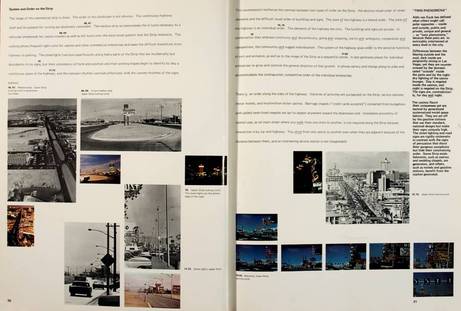
In “Hair, Heir, Heire: Paratextual Modernity and Learning from Las Vegas,” Michael J. Golec will explore how paratextual, or graphic formatting, of Robert Venturi, Denise Scott Brown, and Steven Izenour’s Learning from Las Vegas (1972) and Learning from Las Vegas (1977) influences the textual meaning of these two books. By focusing on the photographic images in the 1972 and 1977 books and in Las Vegas Studio exhibition, Golec asks, “What can we learn from paratextual formatting such that we can have two books that can convey such distinct meanings in their material manifestations?”
Michael J. Golec is an Anshutz Distinguished Fellow in American Studies and Visting Associate Professor of Art and Archaeology at Princeton University. He is an Associate Professor of the History of Design at the School of the Art Institute of Chicago. And, along with Aron Vinegar, Golec is a coeditor of and contributor to Relearning from Las Vegas, published by the University of Minnesota Press. The book is available for purchase at the Graham Foundation.
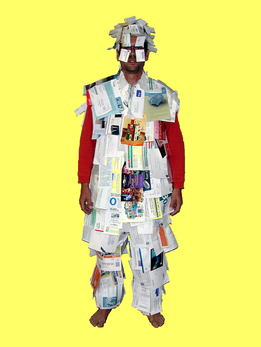
On January 27, 2011, Bill Mackey will give a graphic presentation that discusses the relationship of shoelaces, NCAA basketball, Paris, Oprah, golf carts, street signs, and sex to American perceptions of land use and transportation. The critical analysis utilizes humor and parody to question our roles as actors in society and asks audiences to dream of other possibilities for our landscape.
In 1995, Mackey created Worker, Inc. with the intention of bridging the social sciences, planning, architecture, and art. In 2007, he created the Neighborhood Residents Resources Ethnography Studies Unit, a division of Worker, Inc., to understand local physical environments with an emphasis on data. He conducts on-the-ground research and displays it in small pamphlet publications that combine language, humor, pen and ink drawing, ethnographic research, and graphic arts into a concise and finely executed document that offers a fresh, and often surprising, perspective on human environments. Mackey received a 2010 grant from the Graham Foundation for his Field Guides and Checklists series.
Since 1969, Mackey has had 19 different addresses, 23 bedrooms, 10 pets, 15 jobs, played 25 different sports, ingested 20 types of drugs, had 9 surgeries, been to 2 counselors, visited 16 countries, enjoyed listening to 7 genres of music, tried to play 4 musical instruments, received 3 college degrees, owned 7 bicycles, 4 automobiles and 3 golf carts.
Mackey is an architect and was lead designer for a variety of public and private projects in the southern Arizona region. His architectural design work is recognized in national publications and earns regional design awards. Mackey is a co-founder of the design co*op and was Architect-in-Residence at the Museum of Contemporary Art in Tucson, Arizona in 2009.
Worker, Inc.
http://www.workerincorporated.com/

Venice and Modern Architecture, or Venice and Modernism altogether make an odd couple. According to Filippo Marinetti, the author of the Futurist Manifesto (1909), gondolas are no more than “rocking chairs for idiots.” One hundred years later, we must acknowledge that rather than being its opposite, the passatismo castigated by Marinetti is a powerful aspect of modernity. In fact, John Ruskin’s incantations of the waves of the laguna dangerously rippling against the “Stones of Venice” have transformed the city into one of the 20th century’s proverbial tourist destinations and resulted in an extravagant race against Las Vegas. The lecture is about the architecture of Robert Venturi and Denise Scott Brown and the way it has turned this race into art.
Stanislaus von Moos, a Swiss Art Historian, has published monographs on Le Corbusier (1968ff.), Italian Renaissance Architecture, the History of Industrial Design in Switzerland (1992) and the Architecture of Venturi, Scott Brown & Associates (1st volume 1987; 2nd volume 1999). More recently he published Le Corbusier Before Le Corbusier (ed., with Arthur Rüegg, 2001) and Ernst Scheidegger. Chandigarh 1956 (ed., 2010). Currently he is interested in the culture of the Cold War era and the cross-pollinations between architecture and the visual arts since 1970. He has been professor of Modern Art at the University of Zurich (1983-2005) and is presently the Vincent Scully Visiting Professor at Yale University.
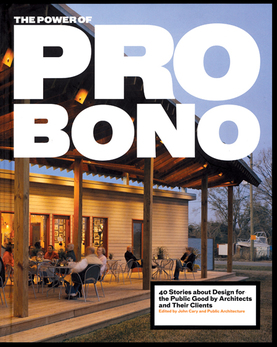
Celebrate the Chicago launch of the book The Power of Pro Bono, with a panel discussion and reception sponsored by Holcim Awards for Sustainable Construction.
The panel will give in-depth perspectives of projects featured in the book, including the Kam Liu Building of the Chinese American Service League in Chicago and the Roosevelt Park Masterplan from Detroit. Representatives from the firm and nonprofit client will be on the panel, moderated by Public Architecture’s Founder and President, John Peterson. The panel will discuss community involvement, the role of pro bono service in professional practice and how design can impact change locally.
Panelists include:
Jeanne Gang// Principal, Studio Gang
Bernarda Wong// President, Chinese American Service League
Noah Resnick// Principal, uRbanDetail
Brian Hurttienne// Architect & Community Activist, Corktown, Detroit
John Peterson// Founder & President, Public Architecture
ABOUT THE BOOK
The Power of Pro Bono presents 40 pro bono design projects across the country. The clients include grassroots community organizations like the Homeless Prenatal Program of San Francisco, as well as national and international nonprofits, among them Goodwill, Habitat for Humanity, KIPP Schools and Planned Parenthood. These public-interest projects were designed by a range of award-winning practices, from SHoP Architects in New York and Studio Gang in Chicago, to young studios including Stephen Dalton Architects in Southern California and Hathorne Architects in Detroit, to some of the largest firms in the country, such as Gensler, HOK and Perkins + Will. Scores of private donors, local community foundations and companies, and material and service donations made these projects possible. So have some of the most progressive funders in the country, ranging from Brad Pitt's Make It Right Foundation in New Orleans to the Robin Hood Foundation in New York. Taken as a whole, the selected works represent six general categories: Arts, Civic, Community, Education, Health and Housing. This book is inspired and informed by the advocacy and design work of Public Architecture, a national nonprofit founded in 2002 by San Francisco-based architect John Peterson. The 1% program of Public Architecture challenges architecture and design firms nationwide to pledge a minimum of one percent of their time to pro bono service, leveraging in excess of $25 million in donated services annually.
ABOUT PUBLIC ARCHITECTURE
Established in 2002, Public Architecture identifies and solves practical problems of human interaction in the built environment and acts as a catalyst for public discourse through education, advocacy, and the design of public spaces and amenities.
Public Architecture
http://www.publicarchitecture.org/home.htm
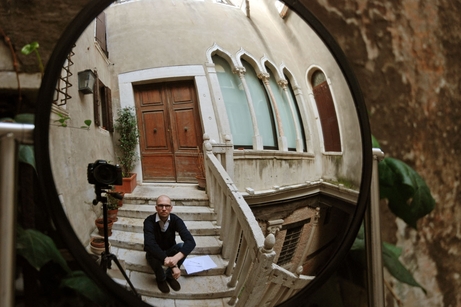
Nicolas Grospierre, TATTARRATTAT, 2010.
Artist Talk: 6PM
Opening Reception: 6:30-8PM
Nicolas Grospierre will discuss the Graham Foundation exhibition and his most recent work. This event is free and open to the public.
Nicolas Grospierre (born 1975, Geneva, Switzerland) lives and works in Warsaw, Poland. He studied sociology at the London School of Economics and political science at the Institut d'Etudes Politique de Paris. In 2008, Grospierre and Kobas Laksa were awarded the Golden Lion for Best National Participant at the 11th International Architecture Exhibition in Venice for the Polish Pavilion project, Hotel Polonia. The Afterlife of Buildings. He works predominantly in an expanded field of photography, exploring the social organization of space. Grospierre's work has been shown internationally in exhibitions in Berlin, Brasilia, Madrid, New York, Venice, Warsaw, among other cities.
Nicolas Grospierre
http://www.grospierre.art.pl/
For more information on the exhibition, One Thousand Doors, No Exit, click here.
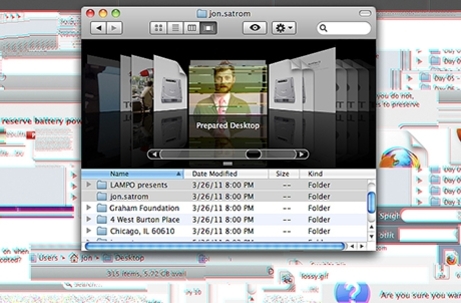
Jon Satrom, Prepared Desktop, 2011
The Graham Foundation and Lampo partner to bring you Prepared Desktop, a new work by Jon Satrom presented in 3-D. For Prepared Desktop, Satrom playfully re-codes conventional computer programs and ordinary operating system elements into a glitch-prone audio/video instrument.
Jon Satrom (b. 1980, Bismarck, N.D.) is a Chicago-based new-media artist who spends his days fixing things, making things work and teaching. He spends his evenings breaking things, learning and searching for the unique blips inherent to the systems he explores and exploits. With a background in video, sound and new media, Satrom has kludged together a collection of home-brew systems for real-time performance, which include custom video games, renegade computer scripts, obsolete display hacks and corrupt data.
Satrom's collaborative projects include I Love Presets alongside Rob Ray and Jason Soliday, PoxParty with Ben Syverson, and Magic Missile with Soliday and Geoff Guy. He has been affiliated with the criticalartware dot net demo krew featuring Jon Cates, Jake Elliott, Tamas Kemenczy and Mark Beasley. He organizes the Chicago GLI.TC/H Festival with Rosa Menkman, Nick Briz and Evan Meaney. Satrom also runs a small production company called studiothread and teaches in the Film Video New Media Animation Department at the School of the Art Institute of Chicago. Satrom first performed for Lampo in June 2009, when he presented the ensemble audio/video project, “Magic Matrix Mixer Mountain,” with Beasley, Cates, Elliott, Kemenczy, Alex Inglizian and Nicholas O’Brien.
Founded in 1997, Lampo is a non-profit organization for experimental music, sound art and intermedia projects. For information and to add your name to the Lampo list, contact info@lampo.org or visit www.lampo.org.
Jon Satrom
http://jonsatrom.com/

The Graham Foundation and the Cultural Services at the Consulate General of France in Chicago are pleased to invite you to celebrate the book launch of Spatial City: An Architecture of Idealism with a presentation and reception at the Graham Foundation on Thursday, March 31st from 6-8 p.m.
The evening will include comments by Laurence Gateau, Director of FRAC des Pays de la Loire, Nicholas Frank, Curator of the Institute of Visual Arts (INOVA) at the University of Wisconsin-Milwaukee and Luis Croquer, Director and Chief Curator of the Museum of Contemporary Art Detroit (MOCAD). The presentations will be followed by a toast and reception with the speakers, French Fonds Regional d'Art Contemporain (FRAC) Directors Emmanuel Latreille and Sylvie Froux, Polly Morris, co-editor of Spatial City and Allison Peters Quinn, Director of the Hyde Park Art Center.
ABOUT THE BOOK
Spatial City: An Architecture of Idealism is the catalog from the first touring exhibition in the United States of works from the French Fonds Regional d'Art Contemporain (FRAC). The exhibition takes the work of utopian architect Yona Friedman—and particularly his idea of the “spatial city”—as a point of departure from which to explore contemporary art within the FRAC collections. Spatial City brings together an international, multi-generational array of artists—with an emphasis on artists living in France—whose work contends with utopian thinking and, in counterpoint, the retreat of optimism in the face of pragmatic reality. The exhibition was on view at the Institute of Visual Arts (INOVA) at the University of Wisconsin-Milwaukee; the Hyde Park Art Center, Chicago; and the Museum of Contemporary Art, Detroit in 2010. The exhibits and catalog were supported by the three venues, Platform (FRAC national organization), the Institut Français, the French Ministry of Culture and Communication and the Cultural Services of the French Embassy in the United States The catalog is published by the Institute of Visual Arts (INOVA) and Platform.
Artists featured in the exhibition include Lida Abdul, Cristian Alexa, Élisabeth Ballet, Yves Bélorgey, Berdaguer & Péjus, Monica Bonvicini, Jeff Carter, Maurizio Cattelan/Philippe Parreno, Jordi Colomer, François Dallegret, Peter Downsbrough, Philippe Durand, Jimmie Durham, Simon Faithfull, Didier Fuiza Faustino, Cao Fei, Robert Filliou, Élise Florenty, Dora Garcia, Ben Hall, Camille Henrot, Séverine Hubard, Pierre Huyghe, Stefan Kern, Bertrand Lamarche, Vincent Lamouroux, Didier Marcel, Raphaël Maze, François Morellet, Sarah Morris, Juan Muñoz, Stéphanie Nava, Philippe Ramette, Sara Schnadt, Kristina Solomoukha, Tatiana Trouvé, Hui-min Tsen, Marie Voignier, herman de vries, Steve Wetzel and Raphaël Zarka.
THE CULTURAL SERVICES OF THE FRENCH EMBASSY IN THE UNITED STATES
The Cultural Services of the French Embassy fosters the best of French arts, literature and education to cultural and academic institutions across the United States with a strong focus on the contemporary.
THE FRENCH REGIONAL CONTEMPORARY ART COLLECTIONS (FRAC)
Since 1983, the French Regional Contemporary Art Collections (FRAC), have played an important part in the history of cultural development in France, promoting and defining the role of art in the life of the country though educational programs, research and the creation of knowledge that improves self-understanding and the understanding of others.
INOVA
Since 1996, the Institute of Visual Arts (Inova) at the University of Wisconsin-Milwaukee has established an international reputation as a contemporary art research center. The mission of the Institute of Visual Arts is to engage the general and university publics with contemporary art from around the world through exhibitions and programs.
MOCAD
The mission of the Museum of Contemporary Art Detroit is to present art at the forefront of contemporary culture. As a non-collecting institution, MOCAD is responsive to the cultural content of our time, fueling crucial dialogue, collaboration, and public engagement.
THE HYDE PARK ART CENTER
The Hyde Park Art Center is Chicago’s place to experience contemporary art. Founded in 1939, the Art Center offers new contemporary art from new and emerging Chicago-based artists, as well as classes and community programs. All Hyde Park Art Center exhibitions are free and open to the public seven days a week.
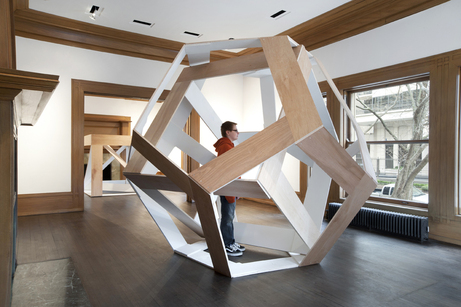
Dodecahedron with nested cube, "Anne Tyng: Inhabiting Geometry," Living Room, Madlener House, Chicago, 2011 © Graham Foundation. Photo: James Prinz Photography.
Anne Tyng: Inhabiting Geometry presents the work of the visionary architect and theorist Anne Tyng. In 1965, Tyng was one of the first women to receive a fellowship from the Graham Foundation. She and curators Ingrid Schaffner, Srdjan Jovanovic Weiss, and William Whitaker will join us for the opening of the exhibition.
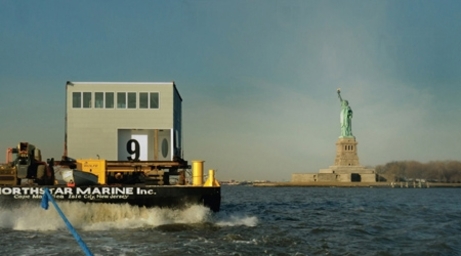
Film still, Saving Lieb House, 2009.
On April 26th, 2011, in anticipation of Chicago’s first Architecture and Design Film Festival, the Graham Foundation and the Festival organizers will partner to present an evening of short films followed by a discussion with filmmaker Jim Venturi. Screenings will include:
Six Pound Chair (Dir. Eames Demetrious, 2004, 5 min.)
Eames Demetrios believes that, along with art and film, design is a process of discovery. By examining Emeco and Frank Gehry's Super Light chair, the Six Pound Chair reveals the inner workings of this process.
Glenn Murcutt: Architecture for Place (Dir. Bruce Inglis, 2010, 11 min.)
Glenn Murcutt is Australia’s most internationally recognized architect. In 1992 he was awarded the Gold Medal of the Australian Institute of Architects; in 1996 he was awarded the Order of Australia (AO); in 2002 he received the Pritzker Prize, considered the equivalent of the Nobel Prize for architecture; and in 2009 he was awarded the Gold Medal of the American Institute of Architects. The short film "Architecture For Place" was made to accompany a touring exhibition of Murcutt's work.
Saving Lieb House (Dir. James Venturi, 2009, 24 min.)
In 1969 world-renowned architects Robert Venturi and Denise Scott Brown designed the world's first pop-art house. Forty years later, when the couple learned that their brainchild would be demolished, they enlisted their son, Jim, and friend and colleague, Fred Schwartz, to save the house. Saving Lieb House documents the 97-mile journey of the house from Barnegat Light, NJ through the rough waters of the Atlantic, under the Verrazano Bridge, past crowds of cheering New Yorkers, the Statue of Liberty, and the Brooklyn Bridge, to its new home in Glen Cove, New York.
James Venturi is a filmmaker and owner of Light From Light Films (LFLF). Venturi is currently working on, “Learning from Bob and Denise,” a documentary on the architecture and ideas of his parents, Robert Venturi and Denise Scott Brown. “Learning from Bob and Denise” was supported by two grants from the Graham Foundation in 2006 and 2009.
From May 5 – 9 The Architecture & Design Film Festival at the Gene Siskel Film Center will showcase 39 films from 11 countries, and feature a dynamic program of films, panel discussions and Q&As with filmmakers, architects and designers and a pop-up architecture bookshop organized and operated by the Graham Foundation.
Architecture and Design Film Festival
http://adfilmfest.com/
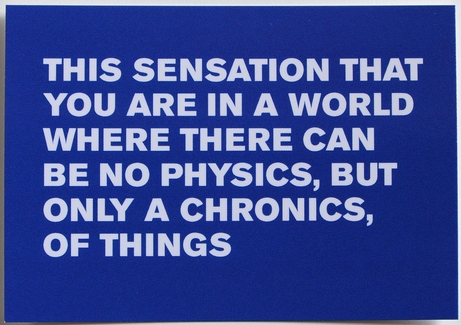
Interested in notions of surprise and abrupt change in sound, Florian Hecker will perform Speculative Solution for the first time in the U.S. on April 30, 2011. Speculative Solution is a series of “micro-chronics” or auditory sequences that range from extreme stasis to the most dynamic intensities. Hecker has set out to create new music exploring philosopher Quentin Meillassoux’s concept of “hyperchaos.”
Here is Hecker’s predicament: it may be impossible to create a rational presentation of hyperchaos because hyperchaos may not be experienceable. While any composition has a finite duration, “hyperchaos is a theory of time, a theory to show that time is not becoming,” as Meillassoux puts it, which we understand as a sort of continuity or reference to the infinite nature of the universe. And, achieving real disorder is impossible anyway, “because disorder is just another form of order than the one you expect,” where fast-moving sound is a cliché of randomness and merely another form of organization…
His performance delivers a perfect combination of theoretical underpinning and drop-dead digital disorientation. Urbanomic, the UK organization that originally commissioned the project, features a conversation between Hecker, Meillassoux and writer Robin Mackay on its website. Click here to access the PDF.
Recent performances by Florian Hecker (b. 1975, Augsburg, Germany) include Push & Pull, Tate Modern, London (2011); Instal, Tramways, Glasgow (2010); Hebbel am Ufer, Berlin (2010) as well as a series of collaborations with Aphex Twin at Warp 20, Cité de la Musique, Paris and Sacrum Profanum, Krakow, both in 2009. Solo exhibitions include MMK Museum für Moderne Kunst, Frankfurt (2010); Chisenhale Gallery, London (2010); Bawag Contemporary, Vienna (2009) and Sadie Coles HQ London (2008). In addition, he has an extensive discography, and he also works closely with visual artists, including Angela Bulloch, Carsten Höller, Florian Pumhösl and Cerith Wyn Evans. Hecker lives in Vienna, Austria and Kissing, Germany.
Hecker last performed at Lampo in October 2006, when he presented a new 6-channel computer work – a hybrid of his artificial neural network piece and other material that later became "Acid in the Style of David Tudor" (eMego 2009). In November 2002 Hecker and Yasunao Tone premiered "Palimpsest" at Lampo, in the duo's first U.S. appearance. Hecker also presented his solo work "Stocha Acid Vlook."
This performance is presented in partnership with Lampo. Founded in 1997, Lampo is a non-profit organization for experimental music, sound art and intermedia projects. For information and to add your name to the Lampo list, contact info@lampo.org or visit www.lampo.org.
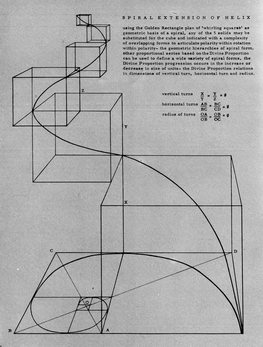
Anne Griswold Tyng, “Form finds Symmetry in Geometry,” in Zodiac 19, 1969
In conjunction with the Graham’s current exhibition, Anne Tyng: Inhabiting Geometry, Alicia Imperiale will discuss Tyng’s seminal essay Geometric Extensions of Consciousness, published in the Italian architectural journal Zodiac 19 in 1969. In the article, Tyng proposes geometries that would open up architectural form by following natural laws of growth in plants and organisms. She writes, "I have found a geometric progression from simplicity to complexity of symmetric forms linked by asymmetric process,"1 and goes on to demonstrate the power of geometry as the invisible driving force in natural forms intrinsic to her research, astonishing drawings, and architectural projects.
Zodiac was published in Milan from 1959-1973. In a number of issues, editor Maria Bottero assembled an extraordinary group of international architects around the themes of geometric studies and the influence of natural systems on architectural design. Imperiale will discuss Tyng’s work in relation to her contemporaries, such as Buckminster Fuller, Zvi Hecker and Alfred Neumann, Keith Critchlow, Robert LeRicolais, Moshe Safdie, Rinaldo Semino, Michael Burt, Renzo Piano, and others, also published in Zodiac.
1 Anne Griswold Tyng, “Form finds Symmetry in Geometry,” in Zodiac 19, 1969, page 139.
Alicia Imperiale, Architect, is Assistant Professor of Architectural History/Theory and Design at the Tyler School of Art, Temple University. Her design and written work focuses on the impact of digital technologies on art, architecture, representation, and fabrication. She is a PhD candidate at Princeton University. Her dissertation is based on the theoretical projects of Italian architect Rinaldo Semino which contextualizes Semino’s work in a larger milieu of megastructural design, cybernetic studies, and radical political events in Italy from 1958-1973. Her essay Organic Italy: The Troubling Case of Rinaldo Semino was recently published in Perspecta 43: Taboo (Yale University Journal of Architecture, MIT Press, 2010). In relation to her work on the politics of the 1960s Imperiale is a co-curator of the exhibit Clip, Stamp, Fold: The Architecture of Little Magazines 196X-197X. She is a contributor to the recent book, of the same name published by Actar/Birkhäuser, 2010. Imperiale has taught design and visual theory at Southern California Institute of Architecture, Pratt Institute, Columbia University, Cornell University, and Parsons School of Design. She holds a B.Arch from Pratt Institute, an MFA in Combined Media from Hunter College and an MA from Princeton University. She was a Van Alen/Dinkeloo Visiting Fellow at the American Academy in Rome.
Imperiale’s article, Dynamic Symmetries in the work of Anne Tyng, will be included in an exhibition catalog co-published by the Institute of Contemporary Art Philadelphia (ICA) and the Graham Foundation. Anne Tyng: Inhabiting Geometry will feature drawings and documentation of projects by Tyng; photographs of the installations at both the ICA and the Graham Foundation; additional essays by Jenny Sabin and Srdjan Jovanoviç Weiss, and an illustrated chronology of Anne Tyng’s life by Ingrid Schaffner and William Whitaker. The catalog will be designed by Project Projects and distributed by DAP.
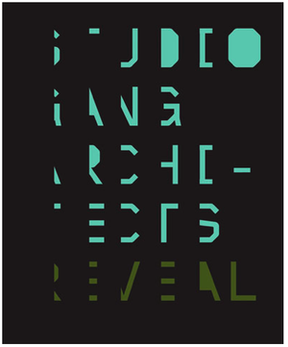
Reveal: Studio Gang Architects
164 North State Street
Chicago, IL 60601
About the Festival
The Architecture & Design Film Festival will showcase 39 films from 11 countries, and feature a dynamic program of films, including Graham Foundation funded films Citizen Architect – Samuel Mockbee and the Spirit of the Rural Studio by Sam Wainwright Douglas, Space, Land and Time: Underground Adventures with Ant Farm by Elizabeth Federici and Laura Harrison, and Wilderness Utopia by Terence Gower. There will also be panel discussions and Q&As with filmmakers, architects and designers.
Graham Foundation Pop-up Bookshop
The Graham Foundation will operate a pop-up bookshop at the Gene Siskel Film Center throughout the run of the festival. Recently published books funded by the Graham Foundation, new publications from William Stout Books and the Architectural Association, and magazines including Joseph Grima’s first issue of Domus and a special issue of Abitare featuring Zaha Hadid will be available.
Jeanne Gang Book Signing
Following a screening of Studio Gang Architects: Aqua Tower, Jeanne Gang will sign copies of her new book Reveal on Sunday, May 8 from 6:30-7:00PM.
The bookshop hours are as follows:
May 5, 8:15 – 10PM
May 6, 3PM – 10PM
May 7, 1PM – 10PM
May 8, 1PM – 10PM
May 9, 6PM- 10PM
For more information on the festival, click here.
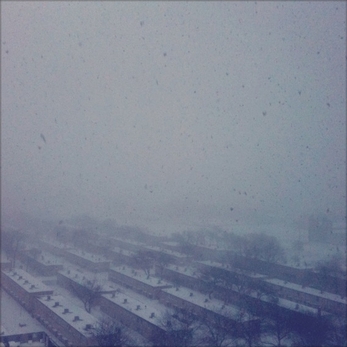
Chicago, 2011
How Chicago Are You? is an evening discussion that will explore the role of place in the production of creative works. Intended to provoke questions about the existence of a regional style, Chicago based practitioners from the fields of art, architecture, cartooning, design and music have been invited to present a selection of images that represent their perceptions about the strengths and pitfalls of the city in which they live and work. Through analysis and conversation, the group will explore whether location has led to trends in artistic production. Panelists include Eve Fineman, Pamela Fraser, Geoff Goldberg, Jimenez Lai, Alex Lehnerer, Damon Locks, Todd Mattei, Anders Nilsen, Robert Somol, and Dan Wheeler. The panel will be moderated by Paul Preissner.
EVE FINEMAN received her B.A. Cum Laude in Architecture from Washington University in St. Louis. After interning at the Smithsonian’s office of Exhibit Design and Production, she shifted her focus to interior environments and furniture design. She moved to Chicago in 1996 to pursue an MFA in Interior Architecture from the School of the Art Institute of Chicago on a full merit scholarship. There she explored the relationships between furniture, sound and the body through architectural installations and experimental furniture. Fineman is Associate Professor of Design at the Illinois Institute of Art, Chicago, where she has been teaching full-time since 2002.
PAMELA FRASER is an American painter. She received her BFA in painting (1988) from the School of Visual Arts in New York and her MFA in New Genres (1992) from UCLA. She has exhibited nationally and internationally and is represented by Casey Kaplan Gallery in New York. Fraser’s solo exhibitions include Galerie Schmidt Maczollek in Cologne, Galleria Il Capricorno in Venice, Asprey Jacques in London, Vedanta Gallery in Chicago, and Casey Kaplan in New York.
GEOFF GOLDBERG has practiced in complex urban and architectural projects for 25 years. A native Chicagoan, he has been teaching design and technology at UIC since 1994. He founded his office in 1992 engaging both architecture and urban design projects. Geoff has an M.Arch. from Harvard University’s Graduate School of Design (1982), a BA from the University of Chicago (1977). He has worked in the offices of I.M. Pei, Bertrand Goldberg, and the Mayor of Chicago, and is currently working on publications on Marina City and mid-20th century Italian mechanical engineering.
JIMENEZ LAI is currently Clinical Assistant Professor at University of Illinois at Chicago. He graduated with an M.Arch. from University of Toronto. Previously, Lai lived and worked in a desert shelter at Taliesin, AZ, and resided in a shipping container at Atelier Van Lieshout on the piers of Rotterdam. Lai has received mentions in competitions in Japan, Europe and the US. Professionally, Lai has worked for MOS, AVL, RE X, OMA /Rem Koolhaas in Rotterdam and New York. In spring, 2011 he exhibited a large scale installation in LOT Gallery in Louisville, Kentucky.
ALEX LEHNERER is an architect and urban designer, received his PhD from the ETH in Zurich and is currently based in Chicago where he holds a position as Assistant Professor at the University of Illinois, School of Architecture. He is partner of Kaisersrot in Zurich, CH, and ALSO Architekten, and the director of the Department of Urban Speculation in Chicago. While appreciating the city as a panoramic projection, his practice explores urban and architectural conditions - their forms, ingredients and rules. This is done both in an academic and professional environment.
alexlehnerer.com
DAMON LOCKS is the frontman for the band the Eternals, creates digital prints, silkscreens and relief prints that play with two sides of “invisibility,” depicting neglected urban spaces, overlooked perspectives and marginalized people, while also envisioning cities not yet visible. Some of his images recombine elements of Chicago, putting train tracks, buildings and buses in new and provocative relations. Locks’ printing process gives these pieces the scabrous texture of cracking brick and concrete, while the hues—in everything from faded walls and smudged “newsprint” to supersaturated skies—endow them with an aura of nostalgia for things to come. From desolate to populous, disconsolate to euphoric, the cityscapes and inhabitants imagined here provoke questions about race, urban planning, and socioeconomic disparity, all oriented around a hope summed up in the words emblazoned on one print: “Tomorrow starts today.”
TODD MATTEI is an artist and musician. He received his MFA in Film/Video/Animation with Honors from Unniversity of Illinois at Chicago in 2005. His individual and collaborative art work has been exhibited in Chicago and the US since 2003. He was a member of the Chicago band Joan of Arc and has produced video and music pieces for film and commercial videos.
ANDERS NILSEN is a popular artist and graphic novelist who grew up in Minneapolis and lives in Chicago, IL. He works on an ongoing comic series, Big Questions (Drawn and Quarterly), which has been nominated several times for the Ignatz Award. In addition, his comics have appeared in the anthologies Kramers Ergot and Mome. His graphic novel Dogs and Water won an Ignatz Award in 2005. An excerpt from Dogs and Water was featured in the inaugural 2006 edition of the Best American Comics anthology, and the book was expanded and reissued in hardcover in 2007. Other, more recent works include a graphic memoir, Don't Go Where I Can't Follow and a comic The End.
ROBERT SOMOL was appointed Director of the School of Architecture at the University of Illinois at Chicago in 2007. An internationally recognized design theorist, Somol was most recently Professor in the Knowlton School of Architecture at Ohio State University and Visiting Professor at the Princeton School of Architecture, and taught design and theory at the University of California, Los Angeles, from 1997-2005. He has served as the Max Fishman Visiting Professor at the University of Michigan and the Cullinen Professor at Rice University, in addition to teaching at Columbia University's GSAPP and Harvard's Graduate School of Design. Somol is the editor of Autonomy and Ideology (Monacelli Press, 1997) and has served on the editorial boards of Any and Log. His writings have appeared in publications ranging from Assemblage to Wired, and focus on modernism and its modes of repetition, the emergence of the diagram in postwar architecture, landscape and interior urbanism, and the development of graphic or cartoon protocols within contemporary architectural practices. He is the co-designer of "off-use," an award-winning studio and residence in Los Angeles that extends his interest in combining the speculative discipline of modernism with the material excesses of mass culture: beinahe nichts meets la dolce vita. As an architectural designer, writer and educator, Somol is a central figure in efforts to displace architecture's modes of criticality by a renewed engagement with the projective ambitions of the discipline. His collection of essays, Nothing to Declare, is forthcoming from ANY Books and the MIT Press, and he is a member of the Research Board of the Berlage Institute in Rotterdam.
DAN WHEELER, FAIA has taught as an Adjunct Associate Professor within the School of Architecture since 1992, being elevated to Associate Professor in 2001. He teaches design, building science, drawing, and design/build. He served as the Interim Director of the school from 2006-7. He is co-author with Clinical Associate Professor Bill Worn of the schools integrated design/building science curriculum. He is past Interim Director of the Graham Foundation for Advanced Studies in the Fine Arts, and remains on the Advisory Board of the Chicago Architecture Club and the Marwen Foundation. Professor Wheeler lectures both nationally and abroad. Wheeler is a practicing architect and is a principal of the Chicago firm Wheeler Kearns Architects. Work of the firm is regularly in print, including the monograph Wheeler Kearns Architects, Ten Houses (1999).
PAUL PREISSNER is an architect and teacher, receiving his undergraduate education in architecture from the University of Illinois and his M.Arch. from Columbia University in New York. He worked for Peter Eisenman, Philip Johnson and Skidmore Owings and Merill, before establishing his own office in 2006. Currently, he is Assistant Professor and the Coordinator of the Master of Architecture program at the University of Illinois at Chicago. His professional practice has developed an international profile through a recognized œuvre of commissioned and competition projects, all of which explore design’s highly visual relationship with its audience. In 2006 he was awarded the second prize in the international open competition to design the Museum of Korean Pre-History in the Gyeonggi-do Provence of South Korea. His architectural work been published and exhibited worldwide and is part of the permanent collection of the Art Institute of Chicago. He and his wife live in Chicago with their dog, Klaus.
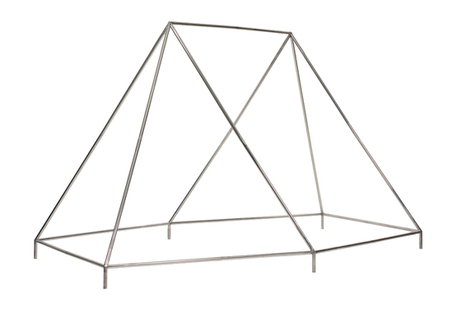
Jonathon Muecke, Frame, Polished stainless steel, 77 x 166 x 100"
The Graham Foundation and Volume Gallery partner to present a talk by Jonathan Muecke in conjunction with Open Objects, his first solo exhibition. Rather than a collection, Muecke considers each of the objects in the exhibition to be its own project, the result being that every one is consistent to its counterparts only in its potential – “a quality that is itself immeasurable.”
Muecke’s projects reflect common forms of design and a continual pursuit of the meta-object. It is within this confrontation, between viewer and object, that development of new thought on functionality and materiality lives. Utilizing materials such as coal slag, glass sand, carbon fiber and gold foil, each piece works to remove our limitations of understanding and encourages the viewer to engage and interact.
A reception in the garden will follow the talk at 5PM.
Open Objects will be on view at Volume Gallery in Chicago from April 30 through May 15, 2011. Visit www.wvvolumes.com for more information.
Graham Foundation grantee Jonathan Olivares wrote about Muecke’s work in Abitare last October. To read the article, click here.
Jonathan Muecke lives and works in Minneapolis, Minnesota. He graduated from the Cranbrook Academy of Art in 2010, where from 2009-10 he was the Florence Knoll Scholar. In 2006 he received a Bachelors of Architecture from Iowa State University followed in 2007 by an internship at the architectural office of Herzog & de Meuron in Basel, Switzerland. In July of 2010 the jury of the Design Parade 5 (Hyéres, France) assigned him the Veuve Clicquot Award. His field of work circulates around the periphery of design.
Volume Gallery is an event-based gallery with a specific focus on American design, and a strong emphasis placed on emerging contemporary designers. The Volume Gallery releases editions, publications and organizes exhibits that showcase the work of American designers to regional, national and international audiences. The Gallery asks critical questions of what it means to be an American designer in a culture that is rapidly becoming more global, while simultaneously examining the American experience.
Jonathan Muecke
http://jonathanmuecke.com/

Anthony Pateras. Photo: Marco Fusinato
For his first Chicago performance, Anthony Pateras will present a new 4-channel work made especially for the occasion – an homage to Henri Chopin, using revoxed voice, manipulated Doepfer synthesizer recordings and prepared piano polyrhythms, performed in the dark.
Anthony Pateras (b. 1979, Melbourne, Australia) is a composer and performer from Melbourne, Australia. He is an idiosyncratic pianist, works with the Doepfer A-100 synthesizer and writes works for ensembles, orchestras and soloists. Pateras explores diverse musical interests through his projects: high velocity piano/drums explorations, electro-acoustic improvising ensembles, extended prepared piano pieces and immersive noise. He has performed or recorded with Han Bennink, Valerio Tricoli, Oren Ambarchi, Jim Denley, Paul Lovens, Fennesz, Thomas Lehn and The Necks. Previous groups include a decade-long duo project with Robin Fox, and the acclaimed free music trio Pateras/Baxter/Brown. He plays regularly throughout the world, and his music is released through the labels Tzadik (New York), Editions Mego (Vienna) and Lexicon Devil (Melbourne). He holds a PhD from Monash University.
This performance is presented in partnership with Lampo. Founded in 1997, Lampo is a non-profit organization for experimental music, sound art and intermedia projects. For information and to add your name to the Lampo list, contact info@lampo.org or visit www.lampo.org.

The Center for Land Use Interpretation, Houston Petrochemical Corridor Landscan, 2010
600 S Michigan Ave.
Chicago, IL 60605
Co-presented by the Museum of Contemporary Photography and the Graham Foundation, Matthew Coolidge, founder and director of the Center for Land Use Interpretation, Culver City, CA, will discuss innovative projects impacting the American landscape and built environment, followed by questions from Graham Foundation director Sarah Herda. This talk is presented in conjunction with the exhibition Public Works at the Museum of Contemporary Photography.
For more information, click here.
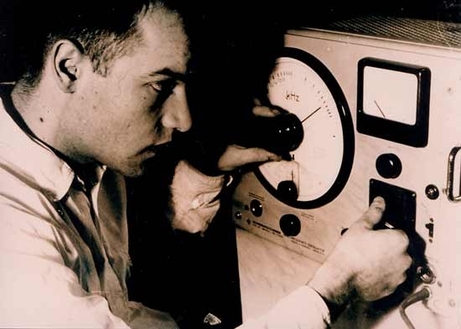
In 2002, Marcus Schmickler presented "<22-gliders>rule," a simulation of cellular automata transforming a string quartet at his Lampo debut. Since then, researchers at Germany’s Argelander Institute for Astronomy, have called Newton’s law of gravity into question.
For his June 11 performance at the Graham, Schmickler takes up these questions in his continuing astronomic investigation, with "particle/matter-wave/energy," a new computer generated composition that asks the question: What does it sound like when galaxy clusters of 30 objects reciprocally influence each other by means of gravitation? Using a sonification of astrophysical data, Schmickler will collide first two, then three simulated galaxies.
Marcus Schmickler (b. 1968, Cologne, Germany) studied composition and electronic music and works in both composed and improvised forms. He has won numerous prizes and honors and is closely associated with the Cologne label a-Musik. As a composer along with his many works of electronic music, he works with the ensemble recherche, the Staatskapelle Weimar, the musikFabrik, the Paragon Ensemble, the Ensemble Zeitkratzer, among others. As a musician he works with artists such as John Tilbury, Thomas Lehn, MIMEO and Julee Cruise. His discography consists of over 50 titles, and he has performed internationally. He lives and works in Cologne.
Schmickler has appeared at Lampo several times–solo in September 2002, together with Thomas Lehn in September 2005, and again solo in December 2007 when he presented the U.S. premiere of "Altars of Science." In May 2009 Schmickler performed at Lampo with Peter Rehberg in the duo's first live appearance.
This performance is presented in partnership with Lampo. Founded in 1997, Lampo is a non-profit organization for experimental music, sound art and intermedia projects. For information and to add your name to the Lampo list, contact info@lampo.org or visit www.lampo.org.
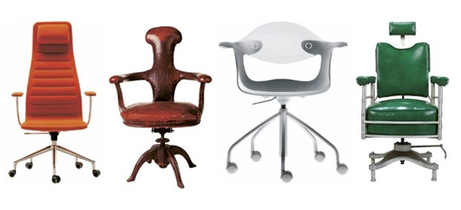
Jonathan Olivares, A Taxonomy of Office Chairs, 2011.
Over the last two hundred years, the office chair has attained cult-like status among the design community and office workers alike. From flexible back supports to mesh webbing, technological enhancements are constantly evolving to meet the changing requirements of the modern worker. With each new development, the office chair confirms its standing not only as an iconic object, but as an important status item.
Filling a significant gap in design history, A Taxonomy of Office Chairs presents the first exhaustive investigation into the office chair's aesthetic and technological evolution. The book features more than 130 of the most innovative chairs from the mid-1800's to the present day, including chairs by Frank Lloyd Wright, Marcel Breuer, Charles and Ray Eames, and Richard Sapper among other notable designers.
On June 14, Olivares will give a talk about his new book. A signing and reception in the garden will follow.
Jonathan Olivares is the founder of Jonathan Olivares Design Research (JODR). JODR is an industrial design office founded in 2006. The office is run on the belief that research and writing on design informs and provokes the design process, and identifies objective goals for it. In addition to providing design services JODR is engaged in sociopolitical and historical research for its clients, which include innovative producers of contemporary furniture and lighting, distinguished museums for design and art, and leading publications on design and architecture.
Olivares is a respected product designer, having designed a number of pieces of furniture for both Danese and Driade. Olivares has taught design workshops at ECAL in Lausanne, Switzerland, at ENSAD in Paris, France and has been a guest designer in the School of the Art Institute of Chicago's Designed Objects program. His products question conventional archetypes and define a culture of function that is specific for today's activity and technology. He recieved a grant from the Graham Foundation in 2010 for his research project, The Outdoor Office. He lives in Boston.
Jonathan Olivares
http://www.jonathanolivares.com/

William Whitaker and Anne Tyng at the opening reception of "Anne Tyng: Inhabiting Geometry," Madlener House, Chicago, 2011 © Graham Foundation. Photo: James Prinz Photography.
Celebrate Anne Tyng: Inhabiting Geometry on its closing day with a talk by William Whitaker. Whitaker, one of the exhibition organizers, will discuss the work of Anne Tyng, who he has worked closely with for many years. Whitaker brought Tyng’s work into the collection of the Architectural Archives of the University of Pennsylvania in 2005. A reception in the garden of the Madlener House will follow the event.
William Whitaker is the curator and collections manager of the Architectural Archives of the University of Pennsylvania—one of the leading repositories of architectural records in the world. He has organized and co-curated over 30 exhibitions, including retrospectives on Louis I. Kahn, Lawrence Halprin, Robert LeRicolais, Antonin and Noemi Raymond and most recently Wharton Esherick. In addition, Whitaker directed research for the landmark retrospective "Out of the Ordinary: the Architecture and Design of Robert Venturi, Denise Scott Brown & Associates", organized by the Philadelphia Museum of Art in 2000. Trained as an architect, he received his undergraduate degree from the University of New Mexico and Master's from the University of Pennsylvania where he teaches as a visiting lecturer in the Historic Preservation and History of Art departments.
The Architectural Archives of the University of Pennsylvania preserves the works of more than 400 designers from the 18th century to the present. For more information, click here.
For more information on the exhibition, Anne Tyng: Inhabiting Geometry, click here.
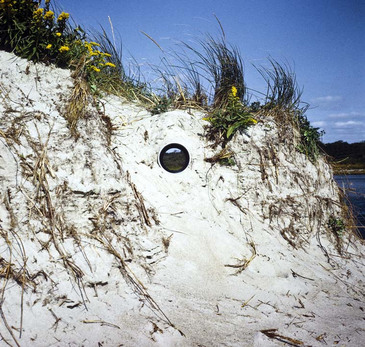
Nancy Holt, Views Through a Sand Dune, 1972, cement-asbestos pipe, sand, Narragansett Beach, Rhode Island.
Join us for an opening reception with Nancy Holt and curator Alena J. Williams.
For more information on the exhibition, Nancy Holt: Sightlines, click here.
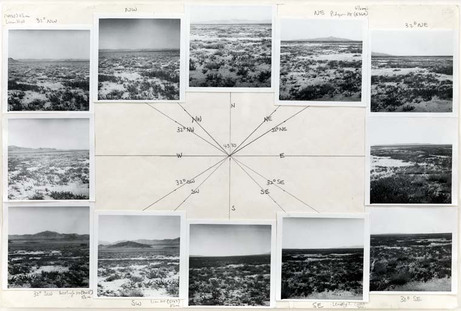
Nancy Holt, Preparatory drawing of “Sun Tunnels,” 1975, pencil and twelve black and white photographs on paper, 14 x 20 in.
In conjunction with Nancy Holt: Sightlines, the Graham Foundation will host a panel discussion, artist talk and book signing on October 8th.
4 PM Panel Discussion: The panel will consider the wider influence of Land Art since the 1960s and 70s, and new perspectives on Nancy Holt’s interdisciplinary oeuvre through a critical rethinking of how the field has come to be defined.
Panelists:
Matthew Coolidge is the founder and director of the Center for Land Use Interpretation, an education and research organization based in Los Angeles, established in 1994. The work of the Center has been presented in museums, universities, and noncommercial exhibit spaces across the United States, and Europe. Coolidge teaches in the curatorial practice program at the California College of the Arts in San Francisco. He is the author and editor of several books, including Overlook: Exploring the Internal Fringes of America with the Center for Land Use Interpretation, Up River: Points of Interest on the Hudson River, and The Nevada Test Site: A Guide to the Nation's Nuclear Proving Ground.
Miwon Kwon is Professor of Contemporary Art History at UCLA. She is the author of One Place after Another: Site-Specific Art and Locational Identity (MIT Press, 2002) as well as numerous essays on an international roster of contemporary artists. She is currently organizing a historical survey exhibition with co-curator Philipp Kaiser entitled “Ends of the Earth: Art of the Land to 1974,” scheduled to open at LAMOCA in spring 2012.
Yates McKee is a PhD Candidate in Art History at Columbia University, and he teaches contemporary art at Cooper Union. His work on art, politics, and ecology has appeared in Grey Room, October, Art Journal, Artforum, Oxford Art Journal, Third Text and Texte Zur Kunst. Most recently, he contributed a text to the catalogue for Allora & Calzadilla's United States Pavillion at the 2011 Venice Bienale.
Ann Reynolds is an Associate Professor in the Department of Art and Art History and the Center for Women's and Gender Studies at the University of Texas at Austin. Her recent publications include essays on Blonde Cobra; Zoe Leonard's So you see I am here after all; Charles Simonds' Urban Dwellings; the politics of emotion; Parker Tyler; and feminist exhibitions and publics circa 1970. She is the author of Robert Smithson: Learning From New Jersey and Elsewhere (MIT Press, 2003) and is currently working on a book project entitled Home Movies: Creativity, Community, and Publics in New York, 1940-1970.
Branden W. Joseph (moderator) is The Frank Gallipoli Professor of Modern and Contemporary Art in the Department of Art History and Archaeology at Columbia University. He is the author of Beyond the Dream Syndicate: Tony Conrad and the Arts after Cage (Zone Books, 2008), Anthony McCall: The Solid Light Films and Related Works (Steidl, 2005), and Random Order: Robert Rauschenberg and the Neo-Avant-Garde (MIT Press, 2003). His writings have appeared in numerous scholarly journals, including Grey Room, a journal of architecture, art, media, and politics, published quarterly by MIT Press since 2000, of which he is a founding editor.
Alena J. Williams (Introduction) is the curator of Nancy Holt: Sightlines, the traveling exhibition on Holt's Land art, films, video, and related works from 1966 to 1980. She is a doctoral candidate in modern and contemporary art in Art History at Columbia University. Williams was a fellow in the postgraduate research group “Media of History – History of Media" at the Bauhaus-Universität Weimar and the recipient of the German Chancellor Fellowship from the Alexander von Humboldt Stiftung. Her publications include Nancy Holt: Sightlines (UC Press, 2011) and Light Is a Kind of Rhythm (merz&solitude, 2009).
7 PM Artist Talk: Nancy Holt will present an artist's talk, which will be followed by a book signing and reception.
"Mining the Wasteland: Land Art's Legacy in Contemporary Art and Politics" is co-presented with The Miriam and Ira D. Wallach Art Gallery, Columbia University.
For more information on the exhibition, Nancy Holt: Sightlines, click here.

Desert Resonator, 2011. Sonic sculpture permanently installed at the CLUI Desert Research Station, Hinkley CA. Deborah Stratman and Steven Badgett.
Framing lines of sight is an unavoidable part of the filmmaking practice. We encircle the gaze with a vectored view and we necessarily remove with every look, editing most of the world out in order to arrive at a shot. Considering the phenomenological power relationships that are native to this simple act are a central part of Stratman's practice. Equally central have been a commitment to landscape, infrastructure, socio-political histories and ways of knowing.
The talk will highlight resonances between some of Stratman’s recent (and future) projects and that of Nancy Holt. In particular, the recent public installations “Desert Resonator” and “Augural Pair,” (collaborations with artist Steven Badgett), and the in-progress “Sinkholes” project. Nancy Holt: Sightlines will be on view at the Graham Foundation from October 7 through December 17, 2011.
Deborah Stratman is a Chicago-based artist and filmmaker interested in landscapes and systems. Her films, rather than telling stories, pose a series of problems - and through their at times ambiguous nature, allow for a complicated reading of the questions being asked. Many of her films point to the relationships between physical environments and the very human struggles for power, ownership, mastery and control that are played out on the land. Most recently, they have questioned elemental historical narratives about freedom, expansion, security, and the regulation of space. Stratman works in multiple mediums, including photography, sound, drawing and sculpture. She has exhibited internationally at venues including the Whitney Biennial, MoMA, the Pompidou, Hammer Museum and any international film festivals including Sundance, the Viennale, Ann Arbor and Rotterdam. She is the recipient of Fulbright and Guggenheim fellowships and she currently teaches at the University of Illinois at Chicago.
For more information on the exhibition, Nancy Holt: Sightlines, click here.
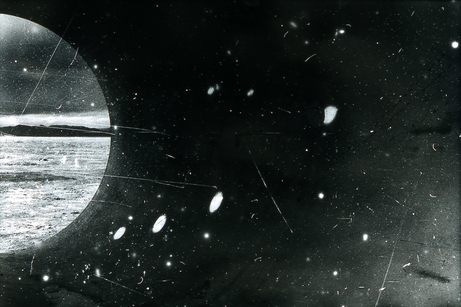
"How did she find herself here? Nancy Holt, 1973-76" A slide installation by Ginger Brooks Takahashi, 1997/2007
Although Nancy Holt has rarely engaged with feminist debates, much of what has been written about her work seeks to inscribe her into a fixed gendered position in relation to the history of Land art. This positioning has historically precluded a more nuanced engagement with questions of artistic production and subjectivity. On the occasion of the Nancy Holt: Sightlines exhibition at the Graham Foundation, two artists—Ginger Brooks Takahashi and Graham Foundation grantee Ines Schaber—consider the role that personal history has played in the reception of Holt's work. Each of them will introduce a new set of propositions on the theme of artistic collaboration through a presentation of their independent work and research in an open discussion format with seminar participants. The discussion will be moderated by Alena J. Williams, Columbia University, New York.
Ines Schaber lives and works in Berlin. She studied fine arts at the Hochschule der Künste, Berlin and architectural theory at Princeton University as a DAAD fellow. She is completing her doctorate in Visual Cultures/Center for Research Architecture at Goldsmiths in London on archival practices in image archives. Her work has been shown at the Storefront for Art and Architecture, New York, Actar Gallery, Barcelona, and KW - Institute for Contemporary Art, Berlin. Schaber was a lecturer / guest professor at a number of international institutions, including the Royal Academy in Copenhagen, the University of Arts in Berlin, Zeppelin University, and the Art Academy in Zurich.
Ginger Brooks Takahashi lives in North Braddock, Pennsylvania and Brooklyn, New York maintaining a social, project-based practice. She produced and performed in the live touring band MEN from 2008 - 2010. She is co-founder of LTTR, a queer and feminist art journal, and projet MOBILIVRE BOOKMOBILE project, a traveling exhibit of artist books and zines. She received her Bachelor of Arts from Oberlin College and is an alumna of the Whitney Independent Study Program. Her work has been presented in the context of exhibitions and programs at the Serpentine Gallery in London, documenta 12 in Kassel, Textile Museum of Canada in Toronto, and the New Museum in New York.
Alena J. Williams is the curator of Nancy Holt: Sightlines, the traveling exhibition on Holt's Land art, films, video, and related works from 1966 to 1980. She is a doctoral candidate in modern and contemporary art in Art History at Columbia University. Williams was a fellow in the postgraduate research group “Media of History – History of Media" at the Bauhaus-Universität Weimar and the recipient of the German Chancellor Fellowship from the Alexander von Humboldt Stiftung. Her publications include Nancy Holt: Sightlines (UC Press, 2011) and Light Is a Kind of Rhythm (merz&solitude, 2009).
Please note that this seminar is open to architects, artists, educators, and graduate and advanced undergraduate students only. Space is limited.
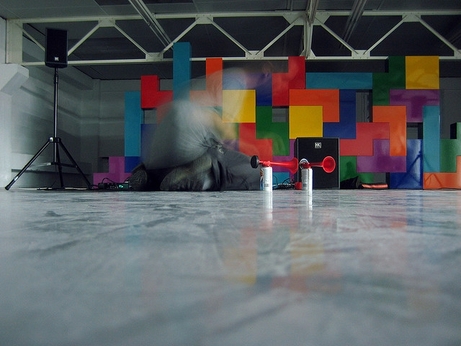
Image: Anna María Ramos
Lampo and the Graham Foundation are pleased to present a performance by Roc Jiménez de Cisneros. Here, in his first Chicago appearance, he will premier “Tetralemma + Tetrafluoroethane,” a new 4-channel work for electronic sounds and hand-held air horns. Present in the work are two subjects: Mereology, or the theory of part-whole relations as it applies to the playback system and compositional structure, as well as the concept of imitation in music, wherein this and other recent performances emulate the aesthetics and techniques in his computer work. Sending similar, but not identical, audio streams to each speaker, Roc attempts to raise several questions: How does the interaction between different channels affect the overall structure of the work? Can we perceive parts within the parts? Can we really focus our attention on one specific source?
Roc Jiménez de Cisneros (b. 1975, Barcelona) is an artist and composer and co-founder of the computer music project EVOL, which began in 1996. His work is a radical and playful exploration of algorithmic composition. Heavily influenced and inspired by cosmology, noise and rave culture, he describes his recordings, installations and performances as "computer music for hooligans." His output has been released on labels such as Entr'acte, Presto!?, Mego, Fals.ch and ALKU, which he runs with Anna Ramos. He has performed extensively throughout the world. He lives and works in Barcelona.
This performance is presented in partnership with Lampo. Founded in 1997, Lampo is a non-profit organization for experimental music, sound art and intermedia projects. For information and to add your name to the Lampo list, contact info@lampo.org or visit http://www.lampo.org.
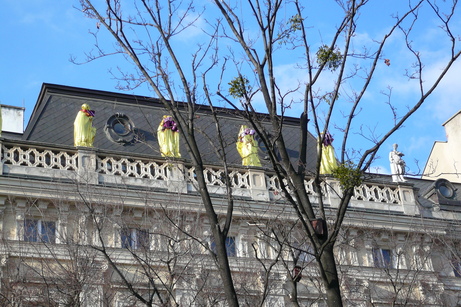
Matej Vakula, Luxury Packaging, 2007, wrapped statues, Academy of Fine Arts & Design, Bratislava, Slovakia. Photograph by Pamela Miller
After the disintegration of the Soviet bloc, personal and collective identity became a major theme for many Central European artists and writers. Freed from the requirement to actively take part in the building of a socialist society, artists began to publicly examine personal histories, national memory, and the impact of Socialist Realism. Throughout the region, newly organized governments began the process of forging new national identities, while also investigating the impact of communism upon individuals and society. It was an idealistic time when many people held the belief that the utopia unrealized under socialism could be built and sustained by adopting democratic and cultural values. This initial civic optimism, which embodied the first post-communist governments and constitutions changed to disillusion as these developing democracies faced the political, cultural and economic pressures of capitalism and globalization.
Reflecting upon the broader cultural milieu, as well as their own work, the panel will discuss how the influences of democracy, capitalism, and globalization have defined contemporary Central European society and culture. They will also address how these forces have impacted the design of the built environment and shaped the generation of artists born after the fall of the Berlin wall.
Janeil Engelstad (USA) is an artist, curator and educator who, working independently and collaboratively, produces exhibitions and projects throughout the world. In 2009 she produced Voices From the Center: Central Europeans Reflect on Life Before and After the Fall of The Berlin Wall, a multiform project that stemmed from her experience as a Fulbright Scholar at the Academy of Fine Arts and Design in Bratislava, Slovakia.
Oto Hudec (SK) is a visual artist whose work includes exhibitions and installations in public spaces that examine immigration, refugees, the rights of indigenous people, and the impact of globalization upon the natural environment. His work has been exhibited throughout the world and was featured in the 2009 Bienal Mercosul in Porto Alegre, Brazil.
Magda Stanová (SK) is a visual artist whose interest lays in urban development, cartography, analysis of creative processes, theory of photography, and history of ownership. In 2008, her book W cieniu fotografii was published by Foundation for Visual Arts in Krakow, Poland and in 2009, she was nominated for the Discovery Award in Rencontre d'Arles festival in France.
Miklós Surányi (HU) is a Budapest based photographer whose images paint an intimate portrait of Hungarian society and culture. He has exhibited throughout Europe and Asia and his work has been published in several Hungarian publications, including limited edition portfolios published by Budapest’s Lumen Gallery.
Matej Vakula (SK) is an artist and curator working in a variety of media, often using public space as a vehicle to explore how the political becomes personal, the personal becomes political, and the politics of site. His work has been exhibited throughout Europe and the United States and has been featured in Art Forum and other media outlets.
Jan Worpus (PL) is a principle at Grafixpol, a design studio based in Łódź, Poland that works in a variety of mediums and formats to create digital and printed materials that convey the ideas, emotions and essence of society and culture. Grafixpol designed the interactive website for Voices From the Center.
This event is co-hosted with Three-Walls in Chicago and is in concurrence with the project Voices from the Center, material of which continues to be presented in lectures and exhibitions throughout Central Europe and the United States. For more information visit http://www.voicesfromthecenter.net/
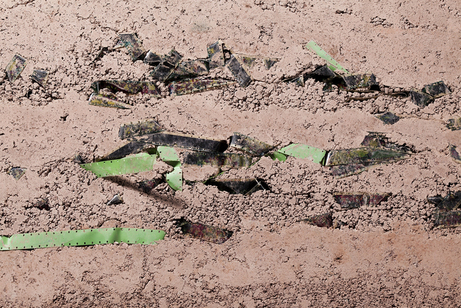
Detail: Karthik Pandian, *Unearth*, Whitney Museum of American Art, 2010
Graham Foundation grantee and artist Karthik Pandian will reflect on the series of 16mm films and sculptural exhibitions that he produced out of his research at the Cahokia Mounds, a complex of pre-Columbian earthen edifices that dot the landscape east of St. Louis, IL, and the ancient Midwestern modernism he found buried there.
Karthik Pandian’s practice seeks to unsettle contradictions — universal and contingent, sacred and profane, proximate and distant — at the heart of the monument. Concerned in particular with the way in which history lurks in matter, Pandian uses 16mm film to excavate sites for fragments of political intensity. The sculptural works that support, enshroud and sometimes obscure his film projections are produced from materials drawn from his site research and often assume the form of architectural constructions. Through moving image, sculpture and syntheses of the two, his work imagines freedom in relation to the impositions of architecture.
Pandian has had solo exhibitions at the Whitney Museum of American Art, New York; Midway Contemporary Art, Minneapolis; White Flag Projects, St. Louis; Richard Telles Fine Art, Los Angeles; and Galerie Meyer Kainer, Vienna. His work has been the subject of numerous published writings, including a feature in Artforum and a catalogue essay by anthropologist Michael Taussig. Pandian's exhibitions have been supported by grants from the Graham Foundation for Advanced Studies in the Fine Arts and the Durfee Foundation amongst others. He received his MFA from Art Center College of Design, Pasadena, CA and his BA from Brown University, Providence, RI.
Midway Contemporary Art
http://www.midwayart.org/exhibitions/10_05_karthik_pandian/
Karthik Pandian: Unearth, Whitney Museum of American Art
http://whitney.org/Exhibitions/KarthikPandian
Related Grant: Before the Sun
http://grahamfoundation.org/grantees/3785-karthik-pandian-before-the-sun
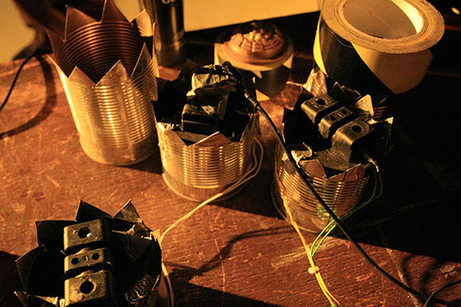
Image: Angeline Evans
Lampo and The Graham Foundation are pleased to present a performance by Leif Elggren as he makes his first Chicago appearance in nearly five years, performing new work for voice and live electronics.
Active since the late 1970s, Leif Elggren (b. 1950, Linköping, Sweden) is a writer, visual artist, art book publisher, stage performer and composer based in Stockholm. His varied and prolific output routinely involves dreams, subtle absurdities and social hierarchies turned upside-down. His audio work, both solo and with the Sons of God (with Kent Tankred), is often created as the soundtrack to an installation or experimental stage performance, and has been released on Ash International, Touch, Radium and his own Firework Edition.
Elggren also is co-monarch (with Carl Michael von Hausswolff) of Elgaland-Vargaland, a so-called digital monarchy that includes all areas of no-man's land, territories between national boundaries on both land and sea, digital and mental spaces.
This performance is presented in partnership with Lampo, and made possible through support from the Graham Foundation, and the American-Scandinavian Foundation. Founded in 1997, Lampo is a non-profit organization for experimental music, sound art and intermedia projects. For information and to add your name to the Lampo list, contact info@lampo.org or visit http://www.lampo.org.

Photo: Susanna Bolle
Lampo and the Graham Foundation are pleased to present Greg Kelley with his premier of Soft Delete/Purgative Dryness, a two-part piece exploring themes of philosophical and aesthetic absence, including the potential absence of meaning and content. The solo work will feature amplified but otherwise acoustic trumpet, in addition to other pre-recorded electronic elements.
Greg Kelley (b. 1973, Boston) began studying the trumpet at age 10. He attended the Peabody Conservatory of Music in Baltimore where, in addition to studying the conservatory curriculum, he immersed himself in the study of avant-garde and experimental music – eventually coming to the conclusion that his musical focus fell outside of the academic sphere. Kelley moved back to his native Massachusetts and inserted himself into the local avant-garde circles. Soon after, he commenced a period of intense travel and collaboration; bringing him across the United States and through Europe, Japan and South America.
Kelley has appeared on over 60 albums and plays in a number of groups including Nmperign (as abstract improvisatory duo and as horn section for ex-Galaxie 500-ers Damon & Naomi), Heathen Shame, the Undr Quartet and the BSC. Other collaborators have included Jandek, Keiji Haino, Donald Miller (Borbetomagus), Anthony Braxton, Kevin Drumm, Christian Wolff, Pauline Oliveros, Joe McPhee and Lionel Marchetti. In addition to playing the trumpet, he also has recorded music using electronics and musique concrète elements.
Kelley serves as the Minister of Fanfares for the Kingdoms of Elgaland-Vargaland, a so-called digital monarchy run by Leif Elggren that includes all areas of no-man's land, territories between national boundaries on both land and sea, digital and mental spaces.
This performance is presented in partnership with Lampo. Founded in 1997, Lampo is a non-profit organization for experimental music, sound art and intermedia projects. For information and to add your name to the Lampo list, visit http://www.lampo.org.
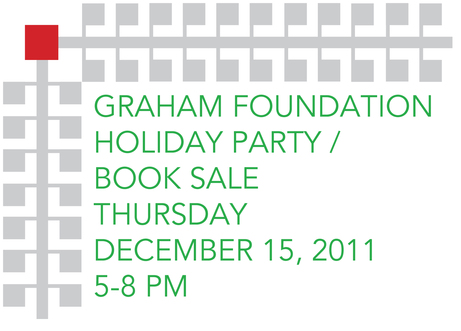
Join us the evening of December 15th for refreshments and a book sale! All books will be discounted at least 15%, with some titles up to 60%. The Graham bookshop is a perfect place to find gifts for that architecture lover in the family (or for yourself!).
Book titles include:
Tomás Saraceno: Cloud Cities
The current exhibition catalog, Nancy Holt: Sightlines
G: An Avant Garde Journal of Art, Architecture, Design and Film
Clip/Stamp/Fold, ed. Beatriz Colomina
The Power of Pro Bono
Reveal: Studio Gang Architects
Living Archive 7: Ant Farm
The complete Words series from the Architectural Association in London
Schlepping Through Ambivalence: Essays on an American Architectural Condition by Stanley Tigerman
Bertrand Goldberg: Architecture of Invention
Architecture in Uniform: Designing and Building for the Second World War
The Complete Architecture of Louis Sullivan
+ more
Periodical selection includes:
Log Journal
Grey Room
Abitare
Mark
Detail
Design Quarterly
Monocle
Icon
Damn
Apartamento
+ more
Hope to see you there!
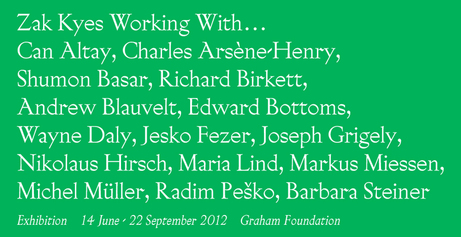
Radim Peško, “Dear Sir, Dear Madam,” typeface, 2011.
'Zak Kyes Working With…' will open with a public reception June 14, 2012. Please join us for a talk by Zak Kyes at 5:30PM, followed by an opening reception and the world premiere book launch of the exhibition catalog published by Sternberg Press from 6-8PM.
For more information on the exhibition, Zak Kyes Working With..., click here.
Unless otherwise noted,
all events take place at:
Madlener House4 West Burton Place, Chicago
GALLERY AND BOOKSHOP HOURS
2025 Chicago Architecture Biennial
SHIFT: Architecture in Times of Radical Change
Sep 19, 2025–Feb 28, 2026
Wed–Sat, 12–5 p.m.
HOLIDAY HOURS: the galleries and bookshop are closed Dec 24, 2025 through Jan 3, 2026
Regular hours resume on Jan 7, 2026
CONTACT
312.787.4071
info@grahamfoundation.org
Accessibility
Events are held in the ballroom on the third floor which is only accessible by stairs.The first floor of the Madlener House is accessible via an outdoor lift. Please call 312.787.4071 to make arrangements.
Copyright © 2008–2026 Graham Foundation. All rights reserved.